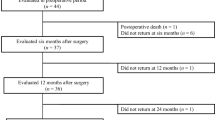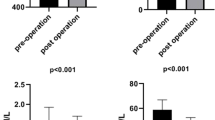Abstract
Background
The aims of this study were to evaluate nitric oxide (NO) metabolites (nitrite/nitrate NO x ) as proinflammatory parameter and total oxidant status (TOS) as well as total antioxidant response (TAR) as oxidative stress (OS) markers in morbidly obese (MO) patients in comparison with normal-weight healthy (NWH) subjects and to determine the post-bariatric surgery changes of NO x and OS indicators in relation with weight loss.
Methods
We examined serum NO x , TOS, and TAR in a bariatric group of MO patients and a NWH control group (n = 23 each group). In the NWH group, serum was examined once, while in the MO group, serum was examined before and at 3, 6, and 12 months after silastic ring vertical gastroplasty (SRVG).
Results
Serum NO x and TOS values were higher (p < 0.001), while TAR level was lower (p < 0.001) in MO patients as compared to the NWH group. No significant changes occurred at 12 months after surgery in the MO group as far as the NO x (p = 0.93), TOS (p = 0.11), and TAR (p = 0.15) levels were concerned as compared to baseline values. However, NO x increased at 6 months after surgery (p < 0.008) and then decreased by the 12th month after SRVG (p < 0.008), reaching almost baseline values.
Conclusions
At baseline, there was a high production of proinflammatory and OS markers in MO patients. SRVG surgical weight loss was not accompanied by significant changes of these parameters at 1 year after surgery.
Similar content being viewed by others
References
Low S, Chew Chin M, Deurenberg-Yap M. Review on epidemic of obesity. Ann Acad Med Singapore. 2009;38:57–65.
Wang Z, Nakayama T. Inflammation, a link between obesity and cardiovascular disease. Mediators Inflamm. 2010;535918:1–17.
Fernández-Sánchez A, Madrigal-Santillán E, Bautista M, et al. Inflammation, oxidative stress, and obesity. Int J Mol Sci. 2011;12:3117–32.
Maury E, Brichard SM. Adipokine dysregulation, adipose tissue inflammation and metabolic syndrome. Mol Cell Endocrinol. 2010;314:1–16.
Martínez JA. Mitochondrial oxidative stress and inflammation: a slalom to obesity and insulin resistance. J Physiol Biochem. 2006;62(4):303–6.
Keaney JF, Larson MG, Vasan RS, et al. Obesity and systemic oxidative stress: clinical correlates of oxidative stress in the Framingham Study. Arterioscler Thromb Vasc Biol. 2003;23:434–9.
Kwang KK, Pyung CO, Quon MJ. Does reversal of oxidative stress and inflammation provide vascular protection? Cardiovasc Res. 2009;81:649–59.
Avogaro A, de Kreutzenberg SV. Mechanisms of endothelial dysfunction in obesity. Clinica Chimica Acta. 2005;360:9–26.
Noroha BT, Li JM, Wheatcroft SB, et al. Inducible nitric oxide synthase has divergent effects on vascular and metabolic function in obesity. Diabetes. 2005;54:1082–9.
Joost HG, Tschop MH. NO to obesity: does nitric oxide regulate fat oxidation and insulin sensitivity? Endocrinology. 2007;148(10):4545–7.
Iyer A, Fairlie DP, Prins JB, et al. Inflammatory lipid mediators in adipocyte function and obesity. Nat Rev Endocrinol. 2010;6:71–82.
Grattagliano I, Palmieri VO, Portincasa P, et al. Oxidative stress-induced risk factors associated with the metabolic syndrome: a unifying hypothesis. J Nutr Biochem. 2008;19:491–504.
Ward M, Prachand V. Surgical treatment of obesity. Gastrointest Endosc. 2009;70(5):985–90.
Buchwald H, Estok R, Fahrbach K, et al. Weight and type 2 diabetes after bariatric surgery: systematic review and meta-analysis. Am J Med. 2009;122(3):248–56.
Deitel M. The early effect of the bariatric operations on diabetes. Obes Surg. 2002;12:349.
Lin LY, Lee WJ, Shen HN, et al. Nitric oxide production is paradoxically decreased after weight reduction surgery in morbid obesity patients. Atherosclerosis. 2007;190:436–42.
Olszanecka-Glinianowicz M, Zahorska-Markiewicz B, Janowska J, et al. Serum concentrations of nitric oxide, tumor necrosis factor (TNF)-alpha and TNF soluble receptors in women with overweight and obesity. Metabolism. 2004;53(10):1268–73.
Pardina E, Ferrer R, Baena-Fustegueras JA, et al. The relationships between IGF-1 and CRP, NO, leptin, and adiponectin during weight loss in the morbidly obese. Obes Surg. 2010;20:623–32.
Sledzinski T, Sledzinski M, Smolenski RT, et al. Increased serum nitric oxide concentration after bariatric surgery—a potential mechanism for cardiovascular benefit. Obes Surg. 2010;20:204–10.
World Medical Association Declaration of Helsinki. Bull of the World Health Organization. 2001;79(4):373–4.
Friedewald WT, Levy RI, Fredrickson DS. Estimation of the concentration of low-density lipoprotein cholesterol in plasma, without use of the preparative centrifuge. Clin Chem. 1972;18:499–500.
Ghasemi A, Hedayati M, Biabani H. Protein precipitation methods evaluated for determination of serum nitric oxide end products by the Griess assay. J Med Sci Res. 2007;2:29–32.
Miranda K, Espey MG, Wink DA. A rapid, simple spectrophotometric method for simultaneous detection of nitrate and nitrite. Nitric Oxide: Biol and Chem. 2001;5(1):62–71.
Ozcan E. A new automated colorimetric method for measuring total oxidant status. Clinical Biochem. 2005;38(12):1103–11.
Ozcan E. A novel automated method to measure total antioxidant response against potent free radical reactions. Clinical Biochem. 2004;37:112–9.
Codoner-Franch P, Tavárez-Alonso S, Murria-Estal R, et al. Nitric oxide production is increased in severely obese children and related to markers of oxidative stress and inflammation. Atherosclerosis. 2011;215:475–80.
Da Silva VRG, Moreira EAM, Wilhelm-Filho D et al. Proinflammatory and oxidative stress markers in patients submitted to Roux-en-Y gastric bypass after 1 year of follow-up. European Journal of Clinical Nutrition. 2012; 1–9
Choi WJ, Pai SH, Kim SK, et al. Increases in nitric oxide concentrations correlate strongly with body fat in obese humans. Clin Chem. 2001;47(6):1106–9.
Cabrera EJ, Valezi AC, Delfino VDA, et al. Reduction in plasma levels of inflammatory and oxidative stress indicators after Roux en-Y gastric bypass. Obes Surg. 2010;20:42–9.
Maniscalco M, de Laurentiis G, Zedda A, et al. Exhaled nitric oxide in severe obesity: effect of weight loss. Respir Physiol & Neurobiol. 2007;156:370–3.
van Dielen FMH, Buurman WA, Hadfoune M, et al. Macrophage inhibitory factor, plasminogen activator inhibitor-1, other acute phase proteins, and inflammatory mediators normalize as a result of weight loss in morbidly obese subjects treated with gastric restrictive surgery. J Clin Endocrinol Metab. 2004;89:4062–8.
Pardina E, Ferrer R, Baena-Fustegueras JA. Only C-reactive protein, but not TNF-α or IL6, reflects the improvement in inflammation after bariatric surgery. Obes Surg. 2012;22:131–9.
Pardina E, Lecube A, Llamas R, et al. Lipoprotein lipase but not hormone-sensitive lipase activities achieve normality after surgically induced weight loss in morbidly obese patients. Obes Surg. 2009;19:1150–8.
Acknowledgments
This work was supported by the research grant from the National Council for Scientific Research in Romanian Higher Education CNCSIS TD code 409 (80/1.10.2007). This study has been presented at the 16th World Congress of IFSO, Hamburg, Germany, Sept. 1–3, 2011. The authors express their great gratitude to Professor Mervyn Deitel, MD, and to Anna Maria Wolf, MD, for their suggestions on the manuscript.
Conflict of Interest
All authors, Adriana Florinela Cătoi, Alina Pârvu, Romeo Florin Galea, Ioana Delia Pop, Adriana Mureşan, and Cornel Cătoi, declare that they have no conflict of interests to disclose.
Author information
Authors and Affiliations
Corresponding author
Rights and permissions
About this article
Cite this article
Cătoi, A.F., Pârvu, A., Galea, R.F. et al. Nitric Oxide, Oxidant Status and Antioxidant Response in Morbidly Obese Patients: the Impact of 1-Year Surgical Weight Loss. OBES SURG 23, 1858–1863 (2013). https://doi.org/10.1007/s11695-013-0968-1
Published:
Issue Date:
DOI: https://doi.org/10.1007/s11695-013-0968-1




